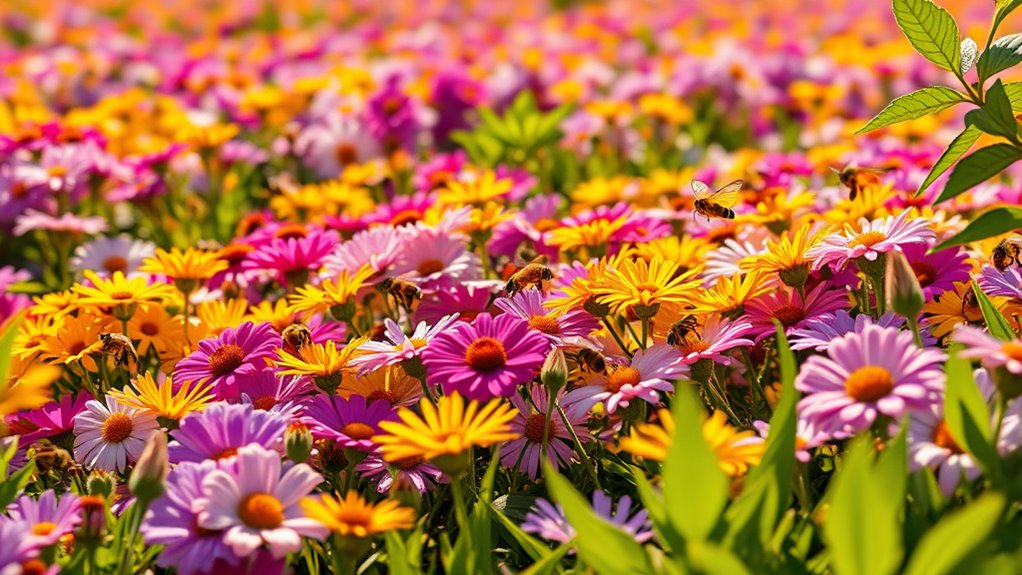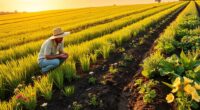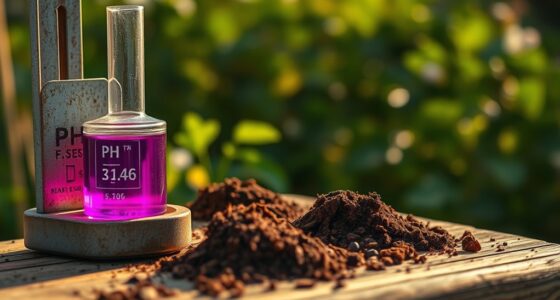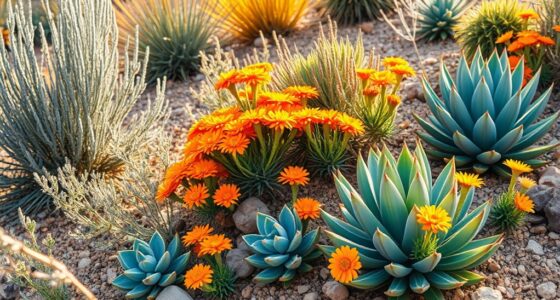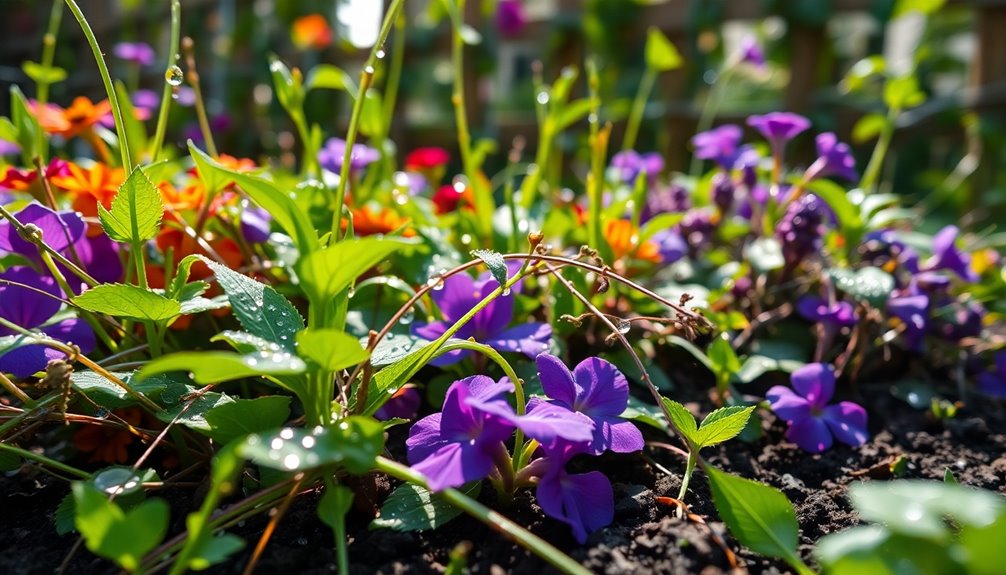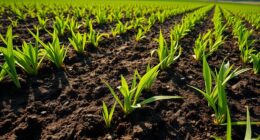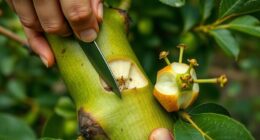To attract pollinators to your farm, plant vibrant flowers like Echinacea and Bee Balm. These blooms provide plenty of nectar and are easy for bees and butterflies to access. Don't forget about annuals like Cosmos and Zinnias, which are favorites among pollinators. For added variety, consider shrubs like Butterfly Bush and Serviceberry. With the right selection, you'll foster a thriving pollinator habitat that boosts your crop yields. There's much more to discover on how to create a pollinator-friendly environment!
Key Takeaways
- Plant native flowers like Echinacea, Anise Hyssop, and Asters to attract various pollinators and provide essential food sources.
- Include vibrant annuals such as Cosmos and Zinnias to draw in butterflies and bees with their bright blooms.
- Incorporate diverse flower shapes and sizes to support a wide range of pollinator species throughout the growing season.
- Create patches of flowers that bloom at different times for continuous food availability from spring to fall.
- Use high-quality compost and natural fertilizers to ensure healthy growth and maximize the attractiveness of your garden to pollinators.
Understanding the Importance of Pollinators
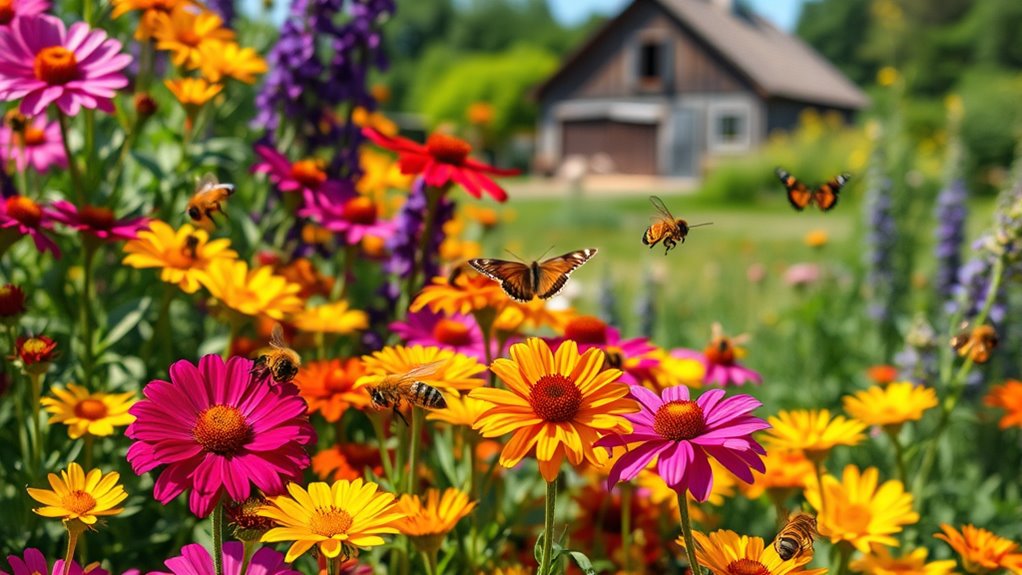
Pollinators play an essential role in our ecosystems, as they're responsible for the reproduction of over 75% of the world's flowering plants and nearly 35% of global food crops.
To support these important creatures, you should focus on planting native plants that provide the specific nectar and pollen they rely on. By doing this, you'll not only attract pollinators but also create a thriving habitat for beneficial insects.
Healthy pollinator populations contribute to diverse food sources, ensuring we've a steady supply of fruits, vegetables, and nuts. Protecting and nurturing these pollinators is vital for maintaining ecological balance and enhancing your garden's productivity.
Ultimately, understanding their importance can lead to a more sustainable environment for everyone.
Characteristics of Pollinator-Friendly Flowers
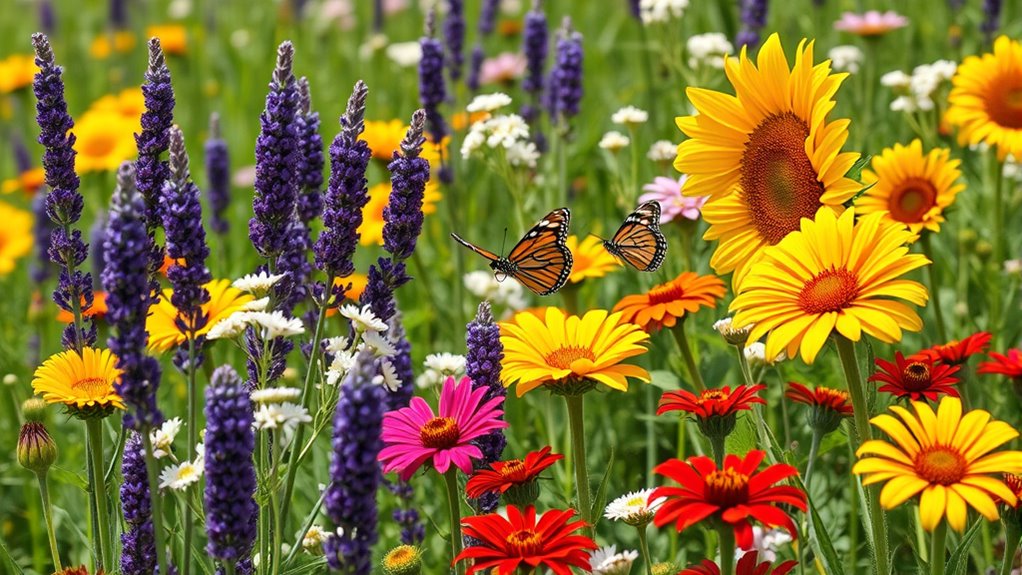
Creating a garden that supports pollinators starts with choosing the right flowers. Look for pollinator-friendly plants that provide essential nectar sources and attract butterflies.
Here are some key characteristics to evaluate:
- Vibrant colors like purple, blue, yellow, or white to draw in bees and butterflies
- Short-tubed or open flowers for easy access to bees
- Tubular-shaped flowers for hummingbirds with long beaks
- A diverse range of flower shapes and sizes to support various pollinator species
- Continuous blooming from spring to fall for a consistent food source
Top Native Plants for Pollinators
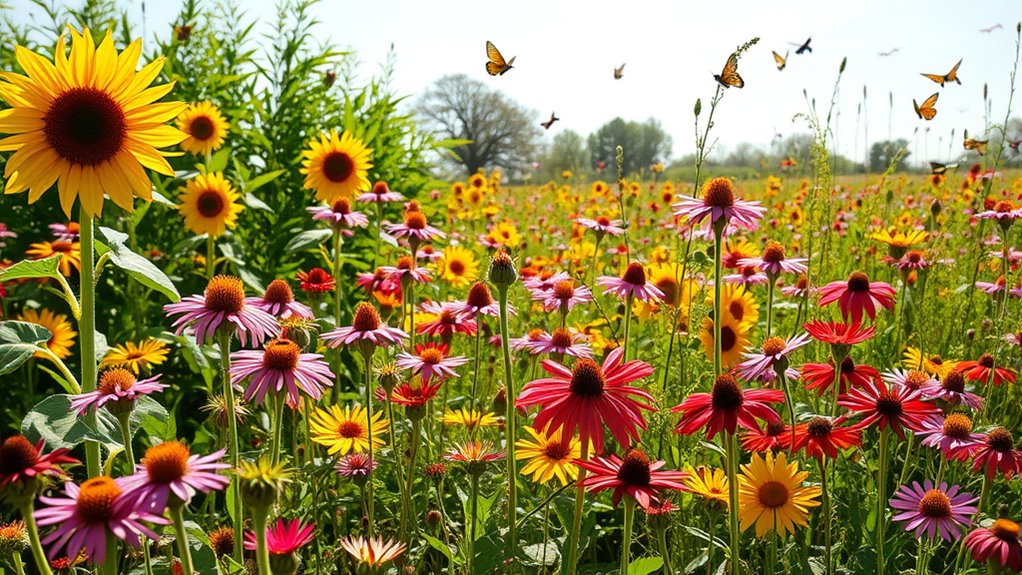
When you choose native plants for your garden, you're not just beautifying your space; you're also supporting local pollinators.
Seasonal blooms play a vital role in providing food throughout the growing season, ensuring these essential creatures have what they need.
Plus, incorporating a variety of native species enhances habitat and biodiversity, creating a thriving ecosystem right in your backyard.
Local Native Species
Incorporating local native species into your garden not only enhances its beauty but also plays an essential role in supporting pollinators.
By selecting plants that thrive in your area, you can create a vibrant ecosystem.
Consider these top native options:
- Echinacea (Coneflower): Attracts bees and butterflies with its nectar-rich blooms.
- Anise Hyssop: Its purple flower spikes draw hummingbirds, honey bees, and butterflies.
- Aster species: Provides vital late-season food sources for pollinators.
- Black-eyed Susan (Rudbeckia): Supports local pollinator populations and offers seeds for songbirds.
- Liatris (Blazing Star): Not only feeds bees and butterflies but also supports beneficial moths.
Seasonal Bloom Importance
To guarantee pollinators thrive in your garden, it's crucial to provide a continuous supply of blooms throughout the growing season.
Seasonal blooms from native plants, like Echinacea and Rudbeckia, offer nectar and pollen at different times, ensuring a steady food source for various pollinators.
By planting different types of flowering species that bloom from spring to fall, you'll attract bees, butterflies, and hummingbirds alike.
Incorporating early-blooming plants such as Anise Hyssop alongside late-blooming species like Goldenrod helps create that important resource flow.
These native plants are adapted to local climates and soils, making them easier to maintain while effectively supporting regional pollinator populations.
A well-planned pollinator garden enhances biodiversity and keeps your local ecosystem thriving.
Habitat Enhancement Benefits
While enhancing your garden's habitat for pollinators, choosing the right native plants is key to supporting local wildlife. Native plants provide essential nectar and pollen, attracting pollinators and boosting biodiversity.
By incorporating these native species, you improve ecosystem resilience on your farm, ensuring a thriving environment for both plants and pollinators.
Consider adding the following native plants:
- Echinacea (Coneflower)
- Rudbeckia (Black-eyed Susan)
- Aster (Asteraceae)
- Monarda (Bee Balm)
- Asclepias (Milkweed)
These plants not only support pollinators' lifecycles but also require less maintenance, making habitat enhancement more sustainable.
Perennials That Attract Bees and Butterflies

When creating a garden that attracts bees and butterflies, choosing the right perennials is key.
You'll want to take into account seasonal blooming patterns to guarantee your garden provides food from spring through fall.
Plus, incorporating native plants can enhance your garden's appeal and support local pollinators.
Top Pollinator-Friendly Perennials
If you're looking to create a vibrant garden that supports pollinators, incorporating perennial plants is a fantastic way to attract bees and butterflies.
Here are some top pollinator-friendly perennials to take into account:
- Bee Balm (Monarda spp.): Its colorful tubular flowers attract bees, butterflies, and hummingbirds.
- Coneflower (Echinacea): This robust perennial blooms from summer to fall, providing nectar for bumblebees and butterflies.
- Anise Hyssop (Agastache foeniculum): With purple flower spikes, it draws in honey bees, bumble bees, and butterflies.
- Blazing Star (Liatris spp.): Tall spikes bloom throughout summer and fall, supporting various pollinators.
- Aster (Symphyotrichum spp.): Critical for feeding monarch butterflies, it blooms when resources are scarce.
Plant these flowers that attract pollinators, and watch your garden come alive!
Seasonal Blooming Considerations
To create a garden that thrives with pollinator activity, you need to select perennials that bloom at different times throughout the growing season. This guarantees a continuous supply of nectar for native pollinators, like bees and butterflies. Here's a quick guide to help you choose:
| Bloom Time | Perennials |
|---|---|
| Early Spring | Anise Hyssop, Bee Balm |
| Summer | Echinacea, Liatris |
| Late Summer | Aster, Goldenrod |
| Fall | Rudbeckia, Yarrow |
| Year-Round | Pollinator favorites |
Native Plant Recommendations
Creating a vibrant pollinator garden starts with choosing native perennials that naturally attract bees and butterflies.
Here are some excellent options for your garden:
- Echinacea (Coneflower): This hardy flower provides rich nectar throughout the growing season.
- Monarda (Bee Balm): Attracts a variety of pollinators with its fragrant blooms.
- Anise Hyssop (Agastache foeniculum): Produces lavender flower spikes and offers edible leaves for herbal teas.
- Blazing Star (Liatris spp.): Blooms from summer to fall, supporting both bees and beneficial moths.
- Coreopsis (Tickseed): A drought-tolerant perennial that attracts pollinators and provides seeds for songbirds.
Incorporating these native plants will guarantee a thriving habitat that attracts pollinators throughout the season!
Annuals to Enhance Pollinator Activity
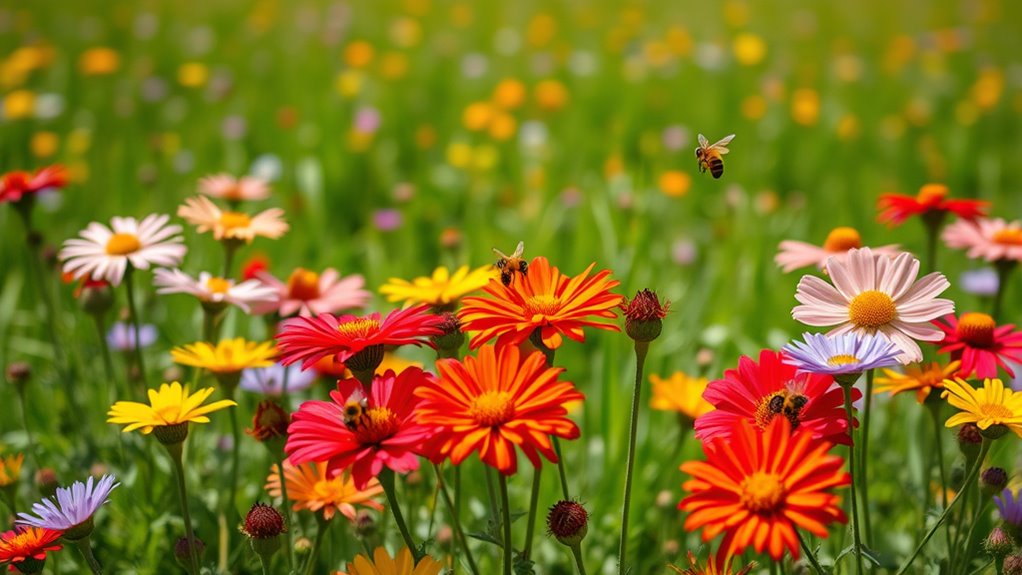
Annuals can greatly boost pollinator activity in your garden, making them a perfect choice for any eco-conscious gardener.
Flowers like cosmos and zinnias are easy to grow and produce vibrant blooms that attract a variety of pollinators. Zinnias, in particular, are a favorite for butterflies, including swallowtails and monarchs.
Basil, especially the African blue variety, offers tall flower spikes that draw in honey bees while allowing you to harvest its aromatic leaves.
Sunflowers, with their bright gold petals, not only attract honey bees and bumblebees but also provide seeds for birds.
Finally, borage features star-shaped blooms that are highly appealing to bees and adds a culinary touch with its edible flowers. Additionally, planting high-fiber plants can enhance the overall health of pollinators by providing essential nutrients in their diets.
Plant these annuals to create a thriving pollinator paradise!
Best Shrubs for Supporting Pollinators
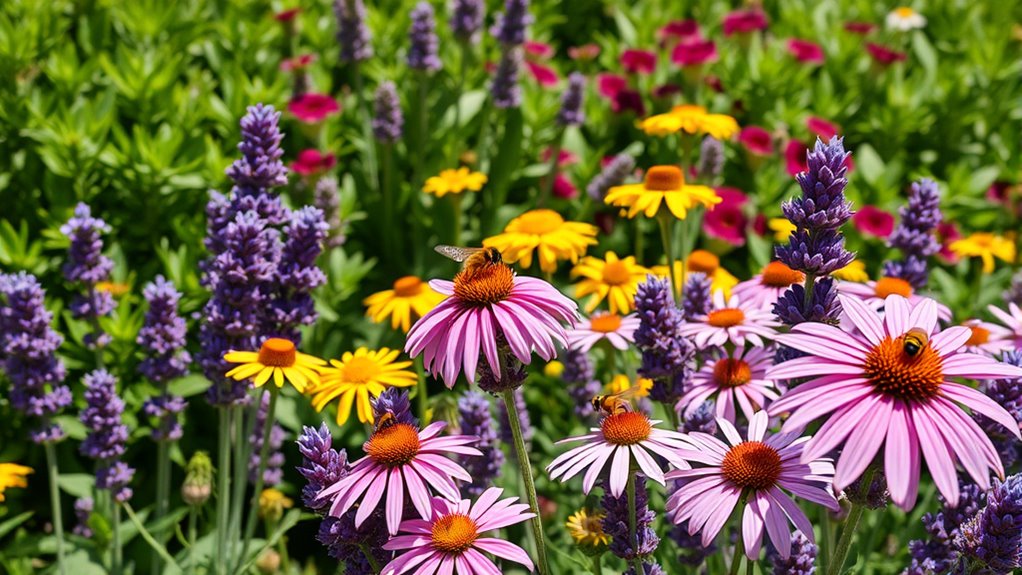
In addition to annuals, incorporating flowering shrubs into your garden can greatly enhance support for pollinators.
These shrubs not only provide nectar-rich blooms but also offer food and habitat for various creatures.
Flowering shrubs enrich your garden by offering essential nectar, food, and habitat for diverse pollinators and wildlife.
Here are some of the best options for your farm:
- Butterfly bush (Buddleja spp.): Attracts butterflies and native bees with abundant blooms.
- Serviceberry (Amelanchier spp.): Early spring flowers for bees and edible berries for wildlife and humans.
- Blueberry (Vaccinium spp.): Bell-shaped flowers draw honeybees and bumblebees, boosting fruit yields.
- Oakleaf hydrangea (Hydrangea quercifolia): Offers large, fragrant blooms and shelter for pollinators.
- Native elderberry (Sambucus canadensis): Supplies nectar and berries, beneficial for pollinators and birds alike.
Incorporating these flowering shrubs can make a significant difference on your farm, especially since pet therapy has been shown to enhance emotional well-being in various care settings!
Planting Strategies for a Pollinator-Friendly Farm
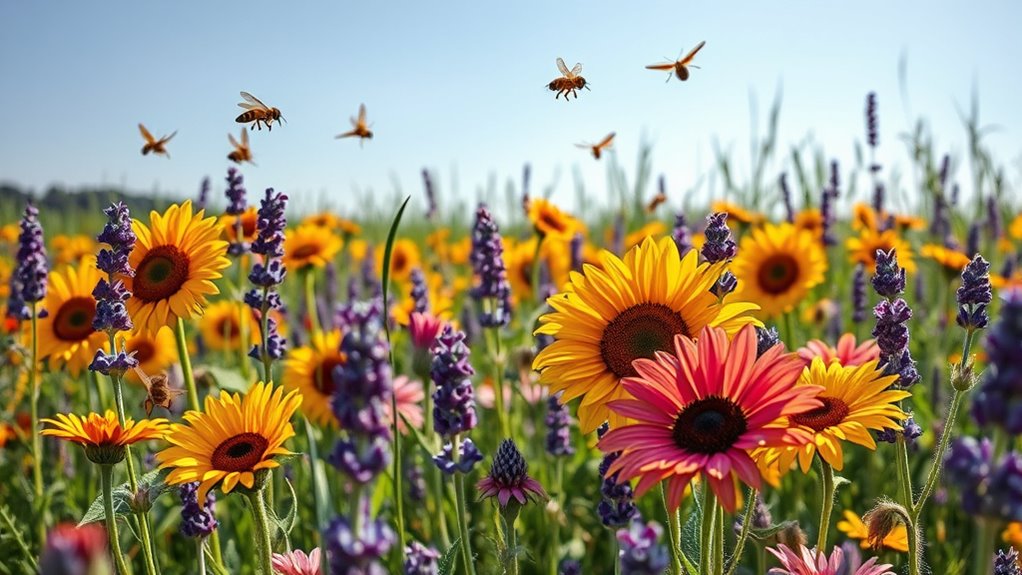
To foster a thriving pollinator-friendly farm, you'll want to implement thoughtful planting strategies that support these essential creatures.
Start with a solid planting plan that includes a diverse range of native plants, ensuring they bloom at different times throughout the growing season. This way, you'll provide a continuous food supply for pollinators.
Plant in clumps rather than singles to enhance movement between flowers, boosting pollination efficiency. Create strips or patches of pollinator-friendly plants that are 3 ft wide and 80 ft long, with 2 ft paths for easy access.
Use high-quality compost and natural fertilizers to help your plants need the nutrients for healthy growth.
Finally, evaluate plant performance over two growing seasons to adjust your selections for maximum attraction of beneficial wasps and other pollinators.
Maintenance Tips for Pollinator Gardens
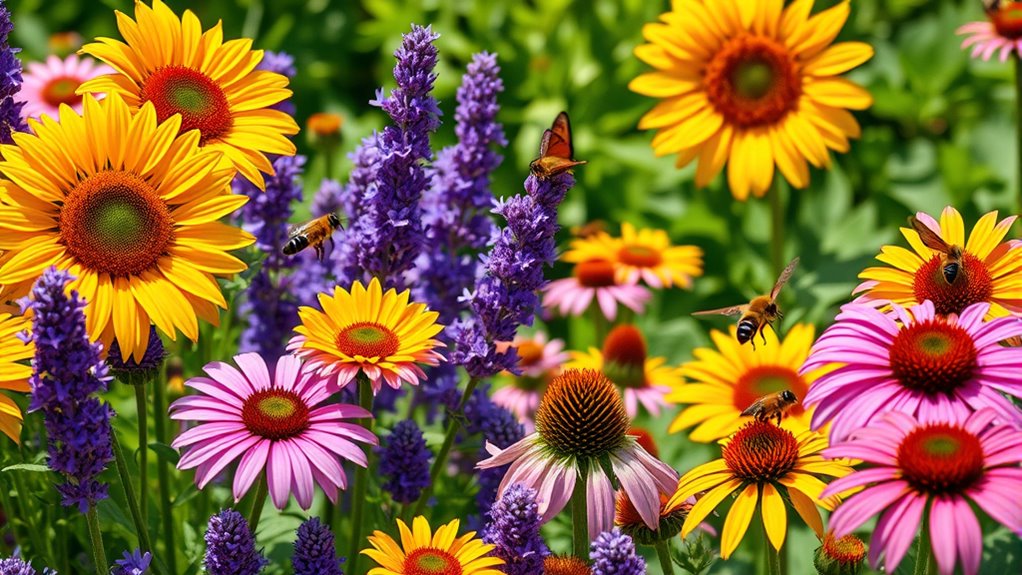
While maintaining a vibrant pollinator garden requires some effort, the rewards are well worth it.
By following these maintenance tips, you'll keep your garden healthy and attractive to pollinators:
- Water young plants deeply twice a week during dry spells to establish strong roots.
- Amend soil with high-quality compost and natural fertilizers to enhance fertility.
- Use mulch around young plants to suppress weeds and retain moisture.
- Space plants 8 to 9 inches apart to create a living carpet effect, promoting a welcoming habitat.
- Evaluate plant performance over two growing seasons to determine which species thrive best in your climate.
These practices guarantee your garden remains lush, supporting the pollinators that are vital for your farm's success.
Frequently Asked Questions
What Flowers Attract Pollinators the Most?
If you want to attract pollinators, focus on flowers with bright colors like purple, blue, yellow, and orange.
Native plants such as Echinacea and Monarda are great choices, as they naturally draw in local pollinators. Adding fragrant options like Anise Hyssop can also help.
Don't forget to include continuous bloomers like Coreopsis to provide a steady food source throughout the season. A mix of herbaceous and annual plants will boost biodiversity, too!
How Do Farmers Attract Pollinators?
To invite nature's busy artisans to your land, you'll want to cultivate a vibrant tapestry of native flowers.
Planting clumps of colorful blooms creates inviting havens for these essential workers. Incorporate perennials for a continuous feast throughout the seasons, and don't forget to add shallow water sources to quench their thirst.
Which Flower Is Best for Pollination?
When you're looking for the best flower for pollination, consider native plants like Coneflower and Bee Balm.
They're rich in nectar and pollen, drawing in a variety of pollinators. Anise Hyssop with its vibrant purple spikes is also great for honey bees and butterflies.
Don't forget Sunflowers; their large centers are a favorite among many pollinators.
Planting in clusters enhances their appeal, making your garden a buzzing haven for beneficial insects.
How Do You Attract Pollinators Quickly?
To attract pollinators quickly, you should plant native flowering species like coneflowers and bee balm.
Creating clumps of these flowers encourages pollinators to move efficiently between blooms.
Don't forget to provide a shallow water source, like a birdbath, for hydration.
Incorporating a variety of colors, especially purple, blue, and yellow, will help draw in different types of pollinators.
Finally, make sure your plants bloom at various times to keep them engaged throughout the growing season.
Conclusion
By incorporating pollinator-friendly flowers into your farm, you not only enhance biodiversity but also boost crop yields. For instance, a farmer in Oregon saw a 30% increase in fruit production after planting native wildflowers alongside their orchards. These vibrant blooms attract bees, butterflies, and other beneficial insects, creating a thriving ecosystem. So, get started today—your plants and pollinators will thank you!

